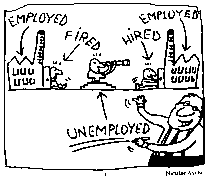The New York Times
March 31, 1994
Economic Scene
A challenge to the complacent on the U.S. unemployment rate.
AS you have heard before and will no doubt hear again, it's America's turn to gloat. The economy is perking along nicely, while unemployment is at its lowest point in three years and still heading south. Japan and Europe, by contrast, remain mired in recession.
Lest the celebration get out of hand, however, remember this: no economist able to pass a sobriety test is predicting that unemployment will fall much below 6 percent. That leaves the economy several million jobs shy of the 3 to 4 percent jobless rate that was considered normal during the 1950's and 1960's. The mainstream economics profession, it seems, is not only becoming reconciled to a 1980's-style world of poorly paying jobs for the unskilled, but has grown complacent to European-style rates of unemployment.
That's why Edmund Phelps's freshly published book, "Structural Slumps" (Harvard University Press), is likely to shake the establishment. For while much of what the Columbia University economist (now working at the Russell Sage Foundation) has to say about the "natural" rate of unemployment has been alluded to before, his ambitious explanation of long-term joblessness may serve as a license for intervention in an area where fatalism has long been fashionable.
In the classical economics that dominated thinking for more than a century, voluntary unemployment was always a temporary phenomenon in free markets. Prices--in this case, wages--would be bid down to the point where everyone willing to work found a job.
 In the 1930's, John Maynard Keynes thought of some clever reasons why unemployment had persisted far longer
than anyone but Marxists had expected, and why it was government's job to intervene But Keynes thought
government was
only there to grease the wheels. He honored the classicists in acknowledging that as long as there was
unemployment, market forces would tend to reduce it. His line, "in the long run we are all dead," simply referred to
the idea that people couldn't afford to wait for the market to work its sometimes lethargic magic.
In the 1930's, John Maynard Keynes thought of some clever reasons why unemployment had persisted far longer
than anyone but Marxists had expected, and why it was government's job to intervene But Keynes thought
government was
only there to grease the wheels. He honored the classicists in acknowledging that as long as there was
unemployment, market forces would tend to reduce it. His line, "in the long run we are all dead," simply referred to
the idea that people couldn't afford to wait for the market to work its sometimes lethargic magic.
"Frictional" unemployment, by the classical way of thinking, would always exist because people were always between jobs. Joblessness might also follow from the accretion of union power or minimum wage laws that blocked the equalization of labor supply and demand. Only in the last few decades have economists strayed from the spirit of 19th-century economics, arguing that some level of unemployment was "natural" because of the divergent incentives of employees and employers.
Probably the most ingenious variations on this theme should be credited to Mr. Phelps, Steven Salop of Georgetown University, Guillermo Calve of the University of Maryland and Joseph Stiglitz, now a member of President Clinton's Council of Economic Advisers.
It makes sense for employers to pay more than the bare minimum to attract workers, they suggested, in order to keep the employees from leaving after they had absorbed valuable skills. And Mr. Phelps argues, premium pay that builds loyalty may even be the order of the day for seemingly interchangeable unskilled employees, so "the workers will not amuse themselves by inserting unpleasant ingredients in the burgers." Competitive wage rates are thus likely to exceed the market-clearing rate, leaving otherwise healthy economies with a variation of what Karl Marx called "the reserve army of the unemployed."
Conservative economists, before and since, have hardly been silent on the questions of what to do about rules, like restrictive union practices and generous unemployment benefits, that artificially reduce the demand or supply of labor. But there has not been much systematic thinking about how the multitude of other factors that drive a modern economy also change the natural rate of joblessness. And that is where Mr. Phelps's book fits in.
The analysis and the statistical evidence supporting it cannot be summarized in time to be absorbed by readers on the 8:18 from White Plains. But the punch lines can: Mr. Phelps attributes much of the rise in natural unemployment since the 1960's to higher payroll taxes, higher real interest rates and the aftershocks from energy price instability in the 1970's and 1980's.
The latter two causes are largely beyond the control of American policy makers, Mr. Phelps notes; both real interest rates and energy prices are determined by world markets. But he argues that it would make considerable sense to shift taxation to forms that do not raise the hourly cost of labor--a national value-added tax, for example. By the same token, he would lower the effective cost of hiring and training the unskilled by subsidizing the wages of those at the bottom of the labor markets.
In recent years, popular economics has had much to say about what works in free economies (ours) and what does not in planned ones (theirs). Mr. Phelps would shift the focus back to how free markets can fail, too. And perhaps it is time: 6 percent unemployment only looks good from the vantage point of the other 94 percent.